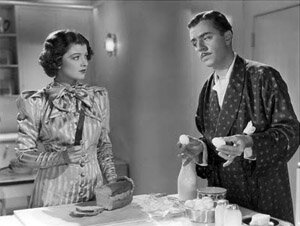 Directed by W.S. Van Dyke
Directed by W.S. Van Dyke
With The Thin Man having such success it was inevitable that a sequel would follow that again featured the popular pairing of William Powell and Myrna Loy as Nick and Nora Charles.
A sequel did follow. It was titled After the Thin Man and not only was it outstanding as far as sequels go, it is arguably an even better movie.
I’m not sure I would argue that but I would definitely say it is on a par with the first Thin Man movie.
And that is surprising since generally sequels fall far short of their progenitors as they scramble to recreate the magic of the first movie.

I think it succeeds for a few reasons: it is more engaging dramatically, which is to say that on screen it is a better story (though I wouldn’t say that is true on paper). I think this is partly because it is more simple and thus less confusing.
It also has to do with the characters of Nick and Nora.
The movie tries, especially in the expository first act, to recreate the quirks and personalities of the first film but as the story takes hold it ceases to push those buttons as much and focuses more on its story. There are Nick and Nora moments throughout but they don’t overwhelm everything else.
So, for instance, the drinking isn’t emphasized to quite the degree as in the first film (though Powell’s Nick speaks throughout as if he is tipsy).
The movie also presents some foils for Powell and Loy to play off of and play to.
There is Jessie Ralph as the matriarchal and hidebound Aunt Katherine (Nora’s relation).

There is the babbling and oppressed Selma Landis (Elissa Landi), another of Nora’s relations, as well as Lt. Abrams (Sam Levene), the baffled and frustrated police investigator.
And there is a fistful of suspicious characters as well, including a youthful (and perhaps a bit green) Jimmy Stewart as David Graham, a former love of Selma’s.
Sequels have an advantage over other movies. Every film has to struggle with the drudgery of setting the story up.
The risk they face is the tedium of the process; they have to look for ways of grabbing the audience’s attention from the start while also conveying necessary information (like who the characters are and what the situation is).
A sequel, especially one like After the Thin Man where a lot of what prompts the sequel is the popularity of the lead characters, simply has to give an audience more of those characters interacting in the way the audience loved the first time. As it begins, it simply needs to provide more of the same.
Here, the movie literally picks up where the previous movie, The Thin Man, ended. And Nick and Nora are being Nick and Nora — just like before.

The movie progresses and introduces other characters — often in ways that has them interacting with Nick and Nora — and soon the scene is set, a murder is committed and the story’s action kicks in.
Sequels are often less successful than the movies that led to them because at this point, they lose their grip. The story in the sequel is less involving than the first.
But in After the Thin Man I think the story is as good as, and in some ways better than the original with its relative simplicity.
It knows the cleverness of the plot isn’t the key to the film; it’s the plot’s ability to engage us enough so we’ll watch more of Nick and Nora.
This movie provides us as an audience with everything we liked about the first movie. It does this eagerly and well but also gives us more engaging drama so the successful formula doesn’t wear out its welcome. It simply leaves us wanting yet more Nick and Nora movies.
And we got them. When they were through, William Powell and Myrna Loy gave us six Thin Man movies. One of the best, perhaps the best, is this one, After the Thin Man.
Do yourself a favour and watch it when you get a chance.
The Thin Man Series:
- The Thin Man (1934)
- After the Thin Man (1936)
- Another Thin Man (1939)
- Shadow of the Thin Man (1941)
- The Thin Man Goes Home (1945)
- Song of the Thin Man (1947)



2 Responses